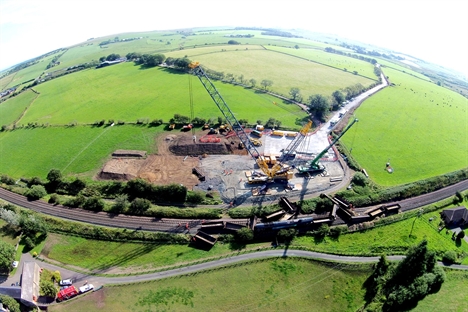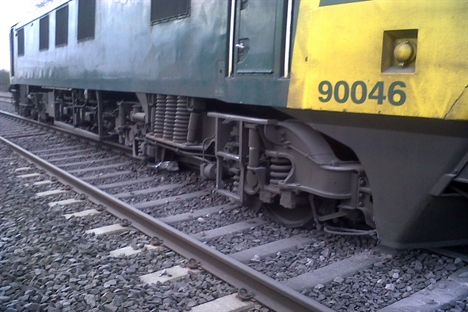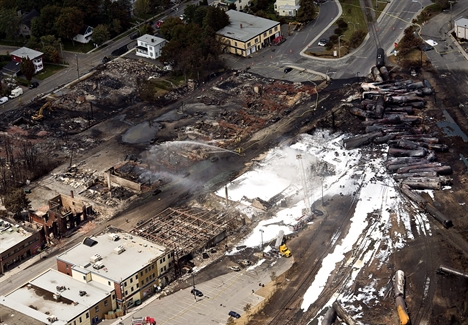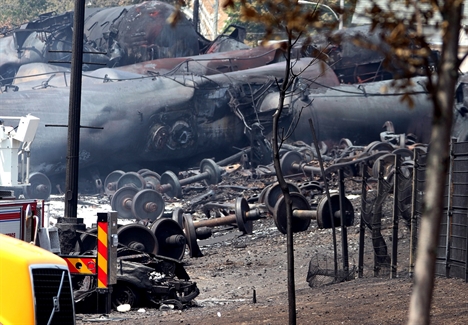01.11.15
Freight derailments: a complex and cross-industry system risk
David Stevenson talks to the organisations responsible for managing the UK’s freight derailment risk, to find out what is being done. He spoke to the ORR’s chief inspector, Ian Prosser, and deputy chief inspector, David Keay; acting chief inspector at the RAIB, Simon French; and George Bearfield, director of system safety at RSSB.
In 2014-15 there were 16 freight derailments on the UK’s rail network, up from 11 the previous year, and the joint worst performance in the last five.
Although none of the incidents led to catastrophic consequences, with no fatalities or injuries, they had the potential. And all of the cases – whether it was the 14 freight derailments or the two cases of freight containers being blown off wagons – caused costly damage to the infrastructure and vehicles.
Efforts have been made to “accelerate dialogue” across the sector to develop a ‘system-level’ solution. In particular, a cross-industry group, facilitated by the RSSB, has been formed. Representatives include Network Rail, freight operators, Huddersfield University and Lloyds Register Rail.
Interconnected factors
The Office of Rail and Road (ORR), also one of the group members, stated that the series of derailments were caused by interconnected common factors. These included issues relating to track condition, in particular track twist; sub-optimal track geometry and the uneven loading of goods in freight containers – causing wheel unloading.
Following a pan-industry meeting in Crewe earlier this year, a number of work streams were developed. David Keay, deputy chief inspector of railways at the ORR, told us: “The primary thrust of the outcome from the seminar is to look again at the standards that pertain to permanent way and track and rolling stock. We have established that if you are on the limit of both, you have a higher probability of wheel unloading and a vehicle coming off the track.”
The RSSB noted that two particular freight derailments investigated by the Rail Accident Investigation Branch (RAIB) on Network Rail metals – at Gloucester and Camden Road West Junction (both October 2013) – raised questions about loading, track condition and compliance with standards.
Track twist faults
Speaking to RTM, Simon French, acting chief inspector at RAIB, said that during the meeting his organisation was trying to express that the industry needs to understand how best to mitigate this area of residual risk given that the railway is changing, the type of traffic is changing and the way in which containers are used for transport is changing.
“The historical norm is changing. We believe the industry needs to look very carefully at these areas and ask itself whether its existing standards are adequate for controlling the risk of derailment,” French noted.
One reason the industry needs to work together is because they will often, at the end of the process, be left with a choice. “The choice ends up [being] between enhancing track maintenance standards and the quality of track maintenance versus changing the characteristics of the wagon versus changing the loading characteristics of the wagons,” said French. “All of these things bring their own costs and levels of effectiveness in controlling the risk of derailment. It is a system-wide issue. It has to be looked at a system level.”
With regards to track twist faults – a variation in the height of one rail relative to another over a given distance – Ian Prosser, chief inspector of railways at the ORR, told us that faults are “not always fixed in the lasting way we would expect”.
For instance, during 2013, the proportion of repeat ‘level 2’ track twist faults – where a track twist fault reappears – increased across the country.
“Some of this is about making sure Network Rail focus on trying to do the permanent fix rather than a short-term fix,” said Prosser. “Too often they go for the short-term fix just to meet the requirements, rather than actually removing the longer-term issue. So, what you see is the repeat fault come back.”
The track twist standard dates back to the 1960 and 70s, when freight trains were shorter, Prosser said. “Now we have much longer vehicles, so it is very important to see that we have the right standards that are fit for purpose with our modern rolling stock.”

Twisted bogies and offset loading
Another area the RAIB wants investigated is the ‘associated risk’ posed by twisted wagon frames.
A recent investigation into a derailment at Angerstein Junction revealed the wagons derailed because the leading right-hand wheel on one of them was carrying insufficient load. But the insufficient load was due to a combination of a track defect, an unevenly distributed residual load in the wagon, and an uneven distribution of load associated with a twisted bogie.
“The reason I mention that report was because it was heavily reliant on evidence we were able to obtain from wheel impact detectors,” said French.
He added that Network Rail’s nationwide programme to install Gotcha, a trackside monitoring system manufactured by Lloyds Register Rail, can play a significant role in identifying long-term risks that might exist with rolling stock that has remained on the wagon for a period of time, like a twist or like a repeated offset load.
George Bearfield, director of system safety at RSSB, which is leading the cross-industry work, told us that a great deal of analytical work is being undertaken to understand the threats, hazards and the various controls that are in place to manage freight train derailments.
“It is really pointing out the need for us to take a fundamental look at the combinational effect of a range of different causes,” he said.
Bearfield noted that loading is one of the big issues that the cross-industry group is focusing on.
“It is not just a rail issue; it has road and shipping implications, because all of the sectors that use transport containers have the same issues,” he said. “Often they [containers] are sealed and you can’t check how they are loaded and it is very difficult to understand the extent to which they are evenly loaded. That is a real assurance problem for a whole range of industries and requires a cross-industry response.”
RTM was told that, following earlier discussions, there are opportunities to look at cranes in container yards that have equipment attached to them that can detect offset loading. The best way to make use of this information is another cross-industry issue that must be thrashed out.
RAIB’s Simon French added that this work is very important, because if an offset load on a container is identified during the journey, “to some extent it is already too late”.
“You have already subjected the infrastructure to the risk of the offset load,” he said. “Once you know you have an offset load it then becomes very difficult to deal with it. There aren’t that many locations where you can shunt the train back, detach the wagon and move on.”
The freight industry is deploying weighing systems at deep sea terminals, but Keay said: “We are trying to encourage them to put weighing at all freight terminals. It means we could pick out a wagon before it actually enters the network. But that also means you have to have accurate vehicle identification and that, again, is an initiative being promoted.”
While the ORR recognises that some of the load factor is outside the direct control of the rail industry, it still needs to manage the consequences.
Underlying cause
Going back to first principles, the regulator’s Ian Prosser stated that Network Rail needs to better manage its track geometry.
“We are pressing them on this. They need to look after the underlying conditions that affect track geometry which, very often, is the drainage condition and embankments themselves.”
He told us that for too long these have been ‘Cinderella’ assets and the ORR has been enforcing on them for the last five years. “Network Rail is getting better and they are getting better knowledge of their embankment and drainage,” said Prosser. “But we had to enforce on their drainage management last year. They had a good plan, centrally, for improving their drainage assets – but they were not implementing it consistently across their routes. They started to comply with that notice through this year.
“Embankments: they still have a long way to go. These assets are being worked harder than they have ever been worked before. And, you know, they are Victorian. It is taking some effort to actually even understand what is in them.
“The most important message I would like to get out is: this work must continue. We had a benign winter last year and a relatively good summer, but we still had the Harbury landslip, a major landslip that took the Chilterns [Mainline] out for many, many weeks.”
A recent RAIB report into a derailment at Heworth station on the Sunderland to Newcastle line in October 2014 found that despite regular faults being reported by Network Rail’s track geometry recording trains, sometimes the faults were not repaired.
It also found that manual reactive repairs carried out by the track maintenance teams were “ineffective”, as the same track geometry faults were recorded repeatedly.
“This information from the track geometry trains is immensely valuable to us as investigators,” said French. “However, if it is valuable to us as investigators it is of even more valuable to the maintainer.
“Our recent investigation into derailment at Heworth revealed there that the issue is often not the availability of the data but the ability to process that data and then deal with the faults that are being identified.”

Lucky
Although no-one ever wants to have to use the word ‘lucky’ in relation to rail safety, that is exactly the definition that the ORR’s Ian Prosser gave RTM.
“We have been relatively lucky,” he said. “Some of [the derailments] have occurred at switches, which means that because of the signalling they are not going to create a collision risk. But we have been, in some cases, lucky.”
RSSB’s George Bearfield agreed with this to an extent, but added that “statistically” – due to the size of the network and the paths of freight trains – “we wouldn’t have expected to have seen worse”.
However, he added that doesn’t mean the regulators or investigators are comfortable if control of the railway is lost in this way.
Bearfield pointed out that the consequences could have been far worse, especially when you consider the Lac-Mégantic rail disaster in Quebec, Canada in 2013 (pictured below).

A freight train carrying 63 tank cars carrying petroleum crude oil derailed and ended up in the downtown area, causing fires and explosions that killed 47 people and destroyed at least 40 buildings.

Platform train interface strategy
In January 2015 the RSSB launched the first industry-wide platform train interface (PTI) strategy, which sets out a comprehensive overview of the sector’s consolidated approach to identifying causal factors and mitigations.
RTM was told that following initial freight derailment workshops a similar programme is going to be developed – but there is no timetable yet. RSSB has commissioned some simulation work to start investigating the margin of safety in the existing assessment of railway vehicle performance on twisted track, and how much that margin of safety accommodates asymmetrically loaded containers.
“The tricky thing is that there isn’t one obvious cause here,” said Bearfield, adding that the RSSB’s work programmes have to be “palatable” to the rest of the industry. That is all part of the wider implementation planning.
Thorough approach required
He added that with the RSSB’s evidence-based approach, it is trying to be proactive and get a hold of this risk and put control measures in place before circumstances create a knee-jerk reaction. “We are trying to help get organised with a clear strategy, and RSSB is the place to do that.”
The ORR told us that while some early actions have been delivered in relation to load weighing, the work is likely to take a couple of years.
“We also need to then make sure the standards are correct going forward, which will take a little time,” said Ian Prosser. “It will probably be next year before we are clear where we want to go with those.”
While the RAIB is not a member of the working group, remaining an independent observer, the organisation’s acting chief inspector, Simon French, told us it is better this work is “done well” and “thoroughly” rather than being “rushed”.
“It is a very complex set of issues that need to be managed,” he said. “But we believe at the RAIB that they are starting to be addressed. The railway is changing and when it starts to change you need to understand how you manage your risks.”